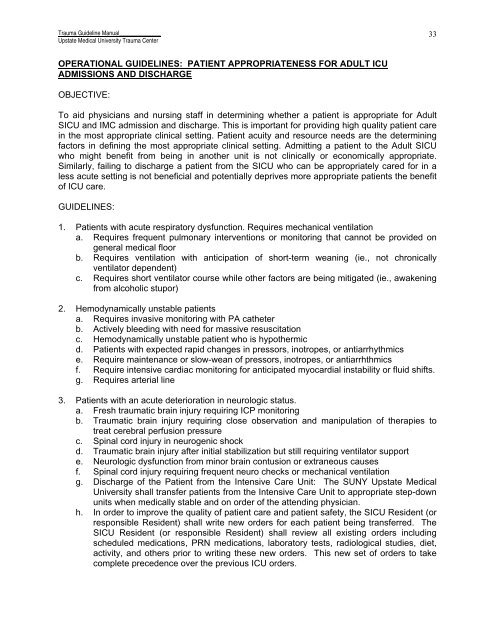Trauma Guideline Manual - SUNY Upstate Medical University
Trauma Guideline Manual - SUNY Upstate Medical University
Trauma Guideline Manual - SUNY Upstate Medical University
Create successful ePaper yourself
Turn your PDF publications into a flip-book with our unique Google optimized e-Paper software.
<strong>Trauma</strong> <strong>Guideline</strong> <strong>Manual</strong>______________<strong>Upstate</strong> <strong>Medical</strong> <strong>University</strong> <strong>Trauma</strong> Center33OPERATIONAL GUIDELINES: PATIENT APPROPRIATENESS FOR ADULT ICUADMISSIONS AND DISCHARGEOBJECTIVE:To aid physicians and nursing staff in determining whether a patient is appropriate for AdultSICU and IMC admission and discharge. This is important for providing high quality patient carein the most appropriate clinical setting. Patient acuity and resource needs are the determiningfactors in defining the most appropriate clinical setting. Admitting a patient to the Adult SICUwho might benefit from being in another unit is not clinically or economically appropriate.Similarly, failing to discharge a patient from the SICU who can be appropriately cared for in aless acute setting is not beneficial and potentially deprives more appropriate patients the benefitof ICU care.GUIDELINES:1. Patients with acute respiratory dysfunction. Requires mechanical ventilationa. Requires frequent pulmonary interventions or monitoring that cannot be provided ongeneral medical floorb. Requires ventilation with anticipation of short-term weaning (ie., not chronicallyventilator dependent)c. Requires short ventilator course while other factors are being mitigated (ie., awakeningfrom alcoholic stupor)2. Hemodynamically unstable patientsa. Requires invasive monitoring with PA catheterb. Actively bleeding with need for massive resuscitationc. Hemodynamically unstable patient who is hypothermicd. Patients with expected rapid changes in pressors, inotropes, or antiarrhythmicse. Require maintenance or slow-wean of pressors, inotropes, or antiarrhthmicsf. Require intensive cardiac monitoring for anticipated myocardial instability or fluid shifts.g. Requires arterial line3. Patients with an acute deterioration in neurologic status.a. Fresh traumatic brain injury requiring ICP monitoringb. <strong>Trauma</strong>tic brain injury requiring close observation and manipulation of therapies totreat cerebral perfusion pressurec. Spinal cord injury in neurogenic shockd. <strong>Trauma</strong>tic brain injury after initial stabilization but still requiring ventilator supporte. Neurologic dysfunction from minor brain contusion or extraneous causesf. Spinal cord injury requiring frequent neuro checks or mechanical ventilationg. Discharge of the Patient from the Intensive Care Unit: The <strong>SUNY</strong> <strong>Upstate</strong> <strong>Medical</strong><strong>University</strong> shall transfer patients from the Intensive Care Unit to appropriate step-downunits when medically stable and on order of the attending physician.h. In order to improve the quality of patient care and patient safety, the SICU Resident (orresponsible Resident) shall write new orders for each patient being transferred. TheSICU Resident (or responsible Resident) shall review all existing orders includingscheduled medications, PRN medications, laboratory tests, radiological studies, diet,activity, and others prior to writing these new orders. This new set of orders to takecomplete precedence over the previous ICU orders.
















